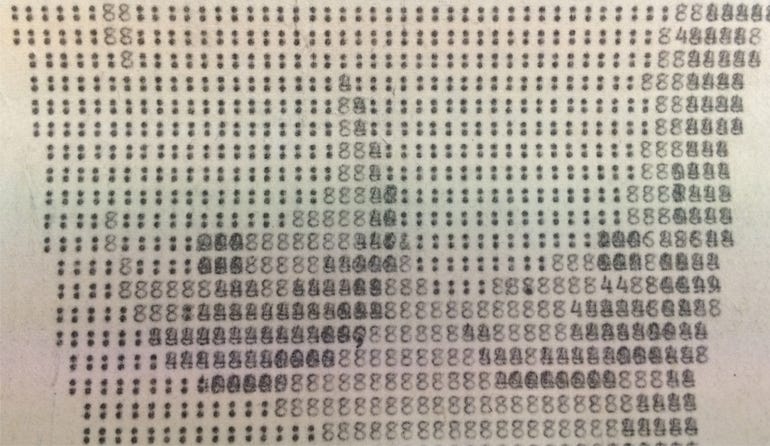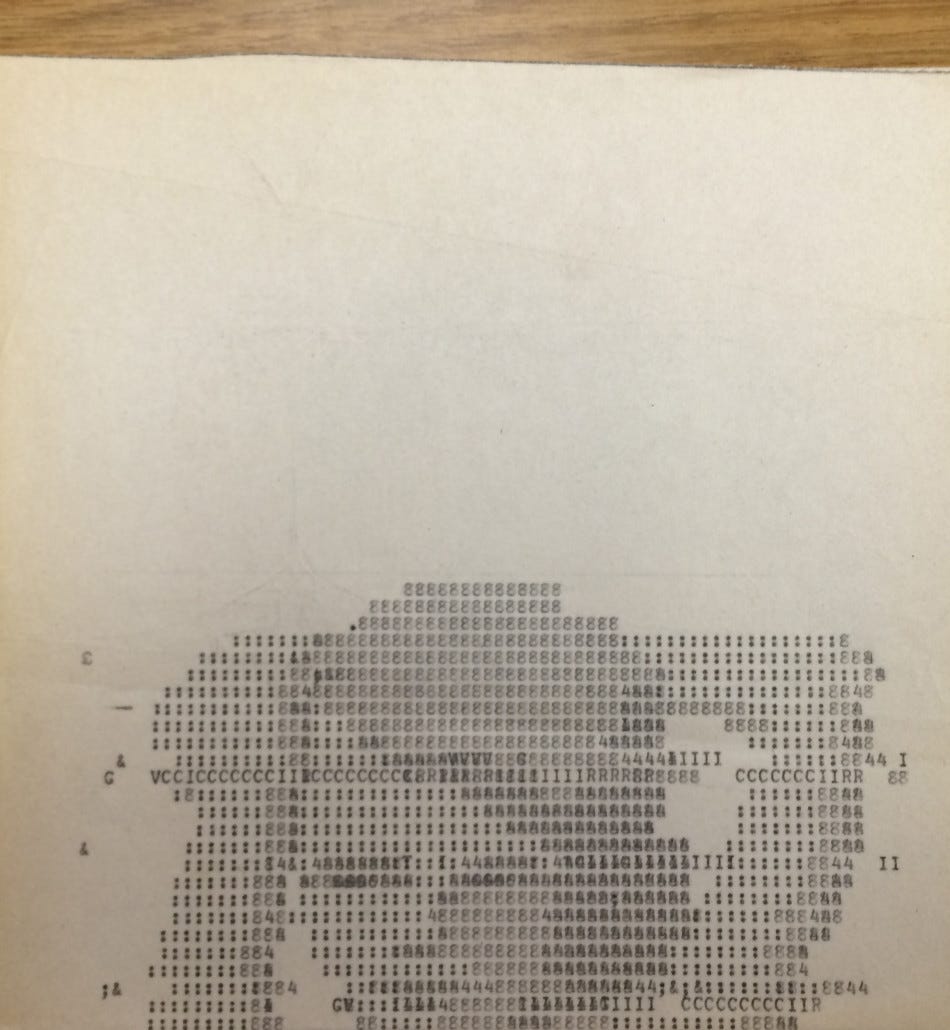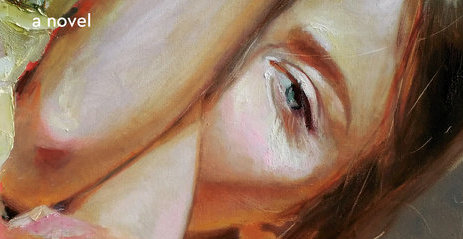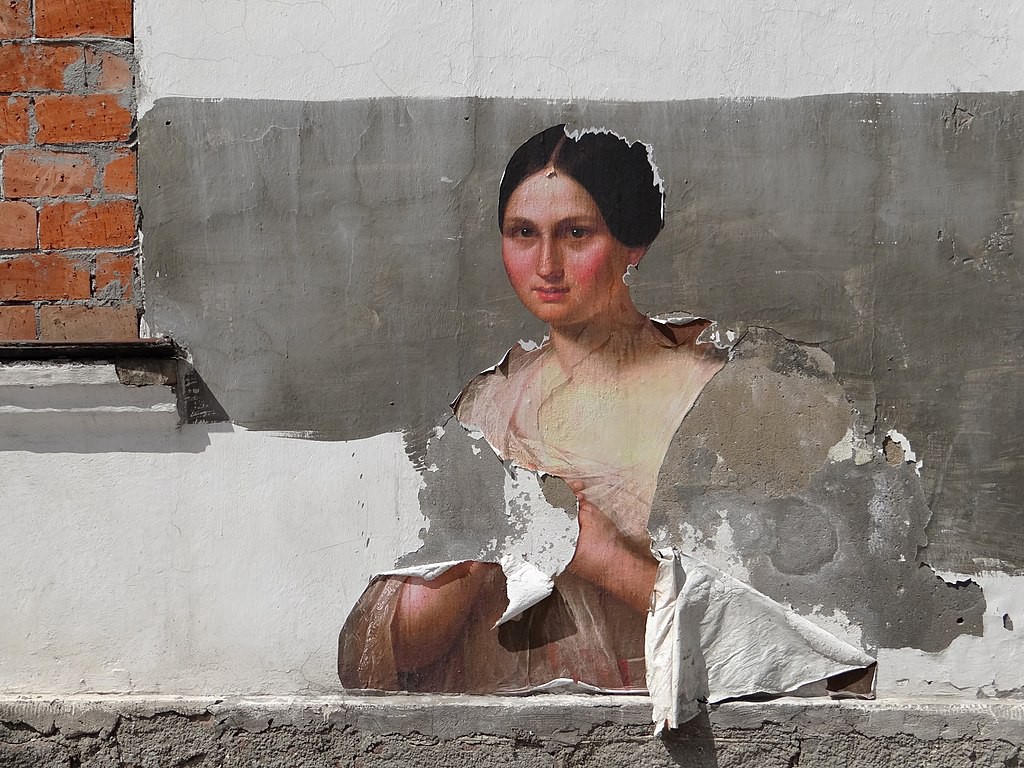Books & Culture
Computer Art and Sex: Another Dispatch from the Kinsey Institute Library

by Ander Monson

Ander Monson’s interest in libraries extends beyond books to the human ephemera found in archives — evidence of previous readers and researchers and archivists among the actual holdings themselves. In July, he visited the world-renowned Kinsey Institute’s library in Bloomington, IN as a Coffee House Press In The Stacks writer-in-residence, continuing his exploration of the physical relationship between a reader and a book in an archive that includes not only the papers of Dr. Alfred Kinsey, but also books, print materials, film and video, fine art, artifacts, and photography related to human investigations of sexual behavior, gender, and reproduction. You can read an interview between Monson and librarians from the Kinsey Institute Library here. Below is part two of a two part dispatch from his residency.
The First Love Picture 2

Untitled, artist unknown, 1968 (Kinsey Institute Library, Indiana University, Bloomington, Indiana)
I still can’t seem to leave Bob and Peg and their amateur sex photo album. I mean I won’t. I’ll carry them with me, how, while fucking on camera — with their shoes on no less — they both look back when the timer goes, as if to celebrate the intersection of their sex and the technology they used to capture it. But then I stumble on another piece, a body made of type, a less transparent use of technology. First, obviously she’s nude. I could include a boob for you, a tit for your titillation, but it’s just colons, 8s, and 4s, arranged; I mean it’s strange: letterform and body, computer art and sex, procured on an American base in Vietnam in 1968.
Below the breasts it’s all those :s, 8s, and 4s. An underarm sports an 8, and a couple 6s too. A few more 8s give shape to the other’s hollow. A & and a 2 perforate her chin. In the lip and face and hair the palette opens further: Cs and Is and Rs, a couple Vs, a random G, a £, and a few ;s here almost as a wink, though this is way pre-emoticon. The use of double-strike for shading is excellently done. Composed on a computer, line-printer printed, probably this is one of an edition outputted for the boys on base.
Is it art? Who cares. I’m fascinated. Downstairs in the Kinsey’s galleries two exhibits (“Secret Impressions: the Mass Production of Erotica Prior to the Camera” and “Hold That Pose: Erotic Imagery in 19th Century Photography”) reinforce the point: give us a tech and we will show you sex. It’s art if we say so. Collect all these artifacts to get at a deeper sense of how we humans work. So the library collects it all, or as much as it can: no little heroism. For instance, it holds an Accu-Jack (a 1970s masturbation machine, forerunner of the more recent RoboSuck). It’s listed in the catalog, under “Accu-jac [realia].”
Realia is a term I didn’t know; it describes not media but everyday objects and materials. Of the 628 pieces of realia in the Indiana University’s library catalog, 414, such as “Rubber Dildo Shaped like a Bride,” “Priest Dildo,” “Plaster Penis Castings,” “Penetrex,” “Doily,” “Treading Chickens,” “Anthropomorphic Vulva,” “Dr. Wing Tip Shoo’s X-Rated Fortune Cookies,” “Copulating Donkeys,” “Altered Butter Package” (“Top from a one-pound box of Land O Lakes unsalted (sweet) butter, decorated with a picture of a kneeling Indian girl who holds a box of butter. The butter box has been cut out and replaced with knees from another box top, thus forming breasts”), “Anal Intruder Set,” “Shithead” (“Head of a man with moustache and bowtie. Made from cow manure. Coated with transparent lacquer. Accompanied by humorous guarantee”), are all in the Kinsey’s collection, because who else would catalog it all? This is why the place is great.
I know I’m just showing you some funny bits (also I really can’t seem to stop; listing them brings me such delight), but funny comes from our discomfort with where sex and culture intersect (which is everywhere the more and more deeply you look). Discomfited yet? It’s okay to joke. Step back a bit. Don’t focus on the punctuation marks and suddenly you see a tit.
I love the thought of those GIs staring at this unnamed woman’s creamy colon-thighs, lit up with desire, in spite of themselves: it was a joke at first but now it’s not. They’re trying not to think about how an alphabet can arouse: anyone who’s written a love letter knows how punctuation hinges things, how a life can seem to hang on a question or an interpretation of a point: how a dependent clause introduces an independent clause and asks to meet to make an answer.
I pause here to consider just when and how a letterform can be a pixel, how the sexual axle turns on the shift from point to line. I’m fine, then boom: something turns me on, as we let the electrical metaphor drive the phrase, and we’ve shifted into another, more excited state. I mean look close enough: we’re all made of unsexy stuff: hairy bits and skin, and, further in: cell walls, cytoplasm, mitochondria, not even to get into the hot atomic bits. It’s in the arrangement and abstraction that things get interesting. Even GI is made of something else: though it’s short these days for “government issue” or “general issue” — a phrase, half-joke (and it’s not my joke to make since I didn’t serve, though I’ll let the sentence stand), meant to ironize disposability, replaceability — it first came from “galvanized iron,” as in what made up supplies, entered in inventories. It’s in these leaps that histories — the better mysteries — are made.









